RXTE Detects "Heartbeat" of Smallest Black Hole Candidate December 21, 2011
An international team of astronomers has identified a candidate for the smallest-known black hole using data from RXTE.
[Goddard Media Studios Article] |
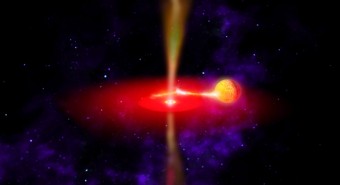 |
Eclipsing Pulsar Promises Clues to Crushed Matter August 17, 2010
Astronomers using RXTE have found the first fast X-ray pulsar to be eclipsed by its companion star.
[NASA Feature Article] |
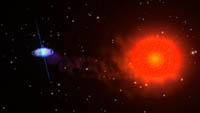 |
RXTE Homes in on a Black Hole's Jets July 1, 2010
RXTE discovers X-rays from black holes' jets outshine the rest of the black hole system.
[NASA Feature Article] |
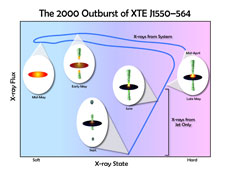 |
RXTE Helps Suzaku catch Retreat of a Back Hole's Disk December 10, 2009
Researchers used Japan's Suzaku and NASA's RXTE satellites to catch a critical change
in the structure of one of our galaxy's most active black-hole binaries.
[NASA Feature
Article] |
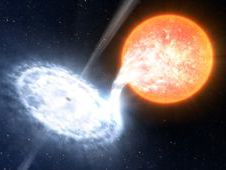 |
NASA Telescopes Explore a Blazar March 18, 2009
Fermi, HESS, RXTE, and Swift team up for unprecedented simultaneous observations of an active
galaxy.
[NASA Feature
Article] |
 |
Top High-Energy Astronomy Prize Awarded to Three RXTE Researchers January 2009
Three RXTE researchers share the Bruno Rossi prize for their measurements of the masses of
Galactic black holes.
[Yale University Press Release]
[Harvard-Smithsonian Center for
Astrophysics News Feature} |
 |
Two Black Holes Teach Astronomers a Lesson October 15, 2008
RXTE coordinates with ground-based telescopes to reveal secrets of "microquasar" black holes.
[NASA Feature
Article] |
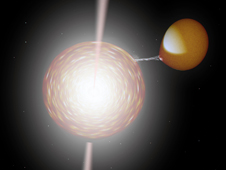 |
RXTE Finds Smallest Known Black Hole April 1, 2008
Nikolai Shaposhnikov and Lev Titarchuk of NASA's Goddard Space Flight Center used RXTE to find
a black hole only 15 miles in diameter. It's the smallest known black hole, and may confirm
theoretical predictions of how small black holes can get.
[NASA
Press Release] [NASA Feature Article]
|
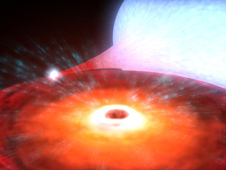 |
Powerful Explosions Suggest Neutron Star Missing Link February 21, 2008
Researcher Fotis Gavriil used RXTE to make an incredible discovery:
"We are watching one type of neutron star literally change into another
right before our very eyes. This is a long-sought missing link between
different types of pulsars."
[NASA Feature
Article] |
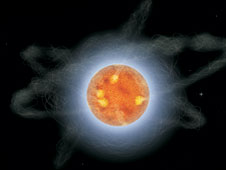 |
NASA Astronomers Find Bizarre Planet-Mass Object Orbiting Neutron Star September 12,
2007
Using NASA's Swift and RXTE satellites, astronomers find not only a rare millisecond pulsar but
a surprising planetary-sized object in orbit around it.
[NASA
Feature Article]
[NASA Press
Release] |
 |
No Matter their size Black Holes 'Feed' in the Same Way December 7, 2006
Researchers use RXTE to reveal that black holes the size of stars and the supermassive black
holes at the hearts of galaxies have some surprising similarities.
[University of
Southampton Press Release]
|
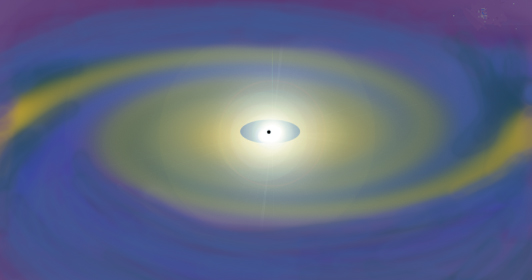 |
Spinning Black Hole Pushes the Limit November 20, 2006
RXTE researchers measure the spin of black holes, and find one spinning over 950 times a second
- close to the theoretical limit, and near the speed of light.
[Harvard-Smithsonian Center for
Astrophysics Press Release]
[NASA
Feature Article] |
 |
Scientists Predict Quakes on Pulsars June 5, 2006
Using RXTE, astronomers discover a "remarkably simple" pattern that
allows them to predict when a pulsar will undergo an explosive "starquake."
[Press Release]
[Computer
Animation] |
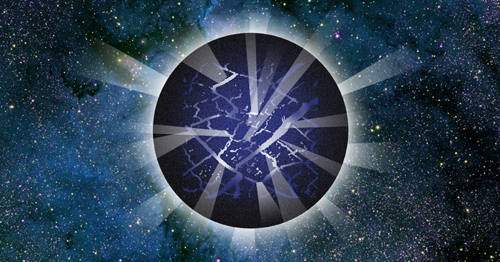 |
NASA Sees Hidden Structure of Neutron Star in Starquake April 24, 2006
[Press Release] |
 |
New Map of Milky Way Reveals Millions of Unseen Objects February 26, 2006
RXTE makes an "X-ray map" of the Milky Way, revealing that the so-called galactic
X-ray background is made up of millions of previously unknown objects.
[NASA
Feature]
[Learning Center] |
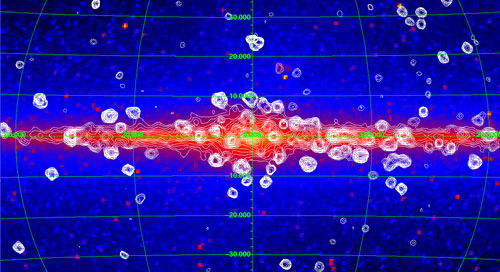 |
Top High-Energy Astronomy Prize Awarded For Clocking Pulsars January 18, 2006
Three RXTE researchers received the 2006 Bruno Rossi prize for their pioneering research
into millisecond pulsars and the star systems that produce them.
[NASA Press Release] |
 |
Scientists Find Black Hole's Point of No Return January 9, 2006
[Press Release] |
 |
Scientists Detect Indentation in Space-Time from Spinning Black Hole
January 9, 2006
[Press Release]
[MIT article and images] |
 |
A Dying Star Reveals More Evidence For A New Kind Of Black Hole January 5, 2006
RXTE researchers find a theorized "in-between" category of black hole that has eluded
and frustrated scientists for more than a decade.
[NASA Press Release]
[NASA
Feature Article, with images] |
 |
Researchers Discover Star Orbiting A 'Medium-Sized' Black Hole January 5, 2006
[Press Release] |
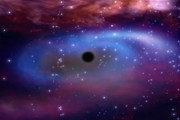 |
NASA's Rossi X-ray Timing Explorer Marks 10 Years in Space January 2006
Designed for a two-year primary mission and a five year extension, NASA's RXTE satellite
exceeds expectations and is still making amazing discoveries after 10 years in space.
[Learning Center] |
 |
Star Eats Companion September 6, 2005
NASA's RXTE and ESA's Integral satellite catch a fast-spinning pulsar devouring its companion
star.
[Press Release]
[ESA Article with
images and animation] |
 |
Three Satellites Needed To Bring Out 'Shy Star' July 13, 2005
RXTE joins two other telescopes to uncover a rare type of neutron star.
[Press Release]
[Images and
further information]
[Learning Center]
|
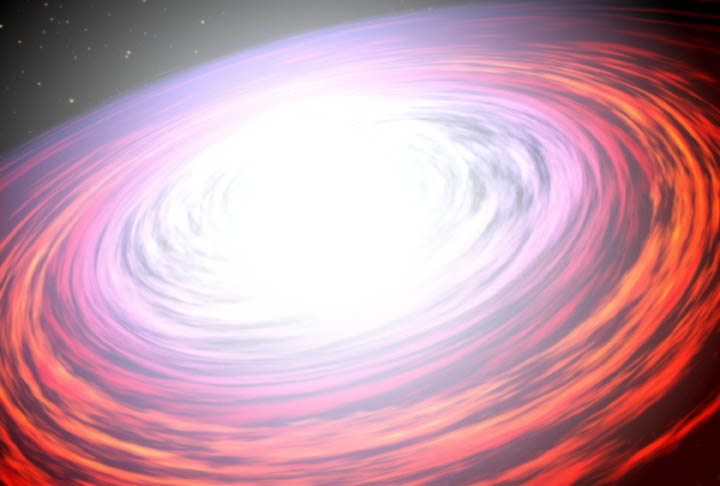 |
Biggest Star Quake In Universe May Reveal Inside of a Neutron Star July 12, 2005
RXTE provides a detailed look at an unprecedented neutron star explosion that may
finally illuminate the mysterious interior of neutron stars.
[Press Release]
[Images and
Animation]
[Sci/Tech Audiences]
| 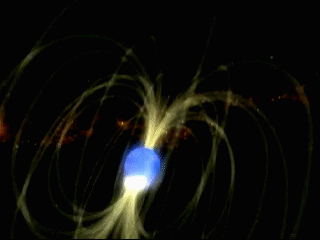
|
Surf's Up: Matter Rides on Wave of Spacetime Around Black Hole January 10, 2005
RXTE researchers find evidence of hot gas riding a "ripple in spacetime" around
a black hole.
[Press Release]
[Images and Animation]
[NASA
Feature Article] |
 |
Scientists Gain Glimpse of Bizarre Matter in a Neutron Star September 8, 2004
Using RXTE, scientists have obtained their best measurement yet of the size and contents of a
neutron star.
[NASA Press Release]
[Images
and Animation]
[Learning Center] |
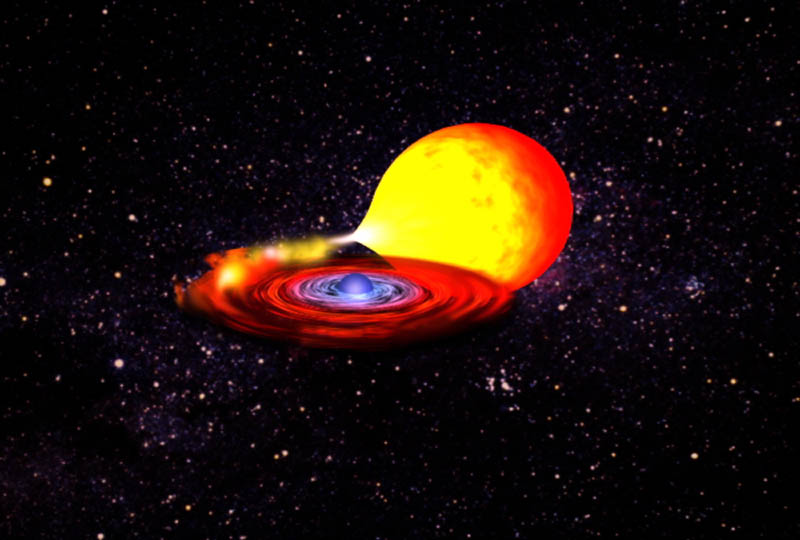 |
Scientists Watch "Movie" of Neutron Star Explosion in Real-Time February 23, 2004
RXTE observations of a superburst halfway across the galaxy provide
scientists with their first-ever look at the moment-to-moment changes the burst
inflicted on the nearby accretion disk.
[NASA Press Release]
[NASA Feature
Article, with images and animation]
[Sci/Tech Audience] |

|
Neutron Star, Turning Into Rare Ultra-Magnetic Object, Reveals Family Tree
January 6, 2004
RXTE researchers find evidence for the first time of a neutron star transforming into
a magnetar.
[NASA Press Release]
[Learning Center] |
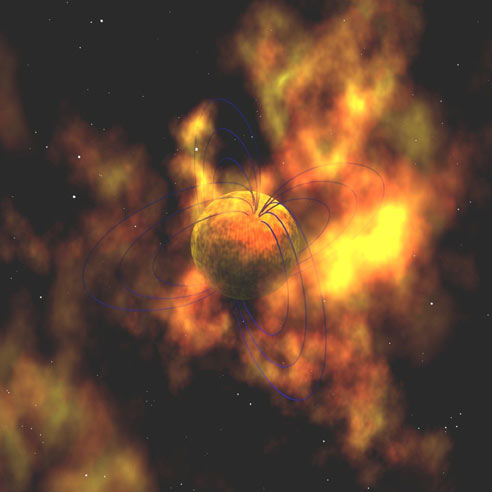 |
Einstein's Gravitational Waves May Set Speed Limit for Pulsar Spin
July 2, 2003
RXTE observations confirm a predicted limit to how fast a pulsar can spin.
[NASA Press Release]
[Learning Center]
[NASA
Feature, with images and animation] |
 |
New Class of Hot-Tempered Black Holes Bucks Trends March 24, 2003
RXTE and XMM-Newton satellites reveal new class of black holes.
[NASA Press Release]
|
 |
Black Holes Really Are Holes, Say Astronomers March 31, 2003
[Press Release] |
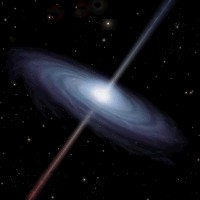 |
Top High-Energy Astronomy Prize Awarded for Ultra-Magnetic Star Discovery January 15,
2003
RXTE researcher Chryssa Kouveliotou shares the 2003 Bruno Rossi prize for confirming the
existance of magnetars, previously theoretical objects now found by RXTE.
[NASA Press Release] |
 |
Famed Eta Carinae, Awash in X-rays, might be Two Stars, Not One January 7, 2003
RXTE data shows that the famous, energetic star cycles in brightness exactly as expected if it
were a binary system.
[NASA Press
Release]
[Learning Center]
[Images at all wavelengths] |
 |
Scientists Measure the Most Powerful Magnet Known November 4, 2002
[Press Release]
[NASA
Feature Article with images and animation]
The Nature of Anomalous X-ray Pulsars September 12, 2002
[Abstract of Paper]
[NASA Press Release] |
 |
|
Going, Going, Almost Gone:Pulsar Whittles Away Stellar Companion to Planet-Size
May 23, 2002
[NASA Press Release]
[Neutron Star Animation]
[Imagine the Universe] |
 |
|
Scientists Catch Speeding Neutron Star With "Radar Gun" Technique,
Confirm Theory
April 22, 2002
[NASA Press Release]
[Neutron Star Animation]
[Imagine the Universe] |
 |
|
Vampire Pulsar Sucks Companion Star Down to Planet-Size
April 22, 2002
[NASA Press Release]
[Neutron Star Animation]
[Imagine the Universe] |
 |
|
Scientists Find "Local" Black Hole Pumps Energy As It Spins
April 22, 2002
[NASA Press Release]
[Black Hole Animation]
[Imagine the Universe] |
 |
|
Prime View of Neighbouring Galaxy Yields Pulsar Bonanza, Seven in One Blow
January 9, 2002
[NASA Press Release]
[Images]
[Imagine the Universe] |
 |
|
"Big Glitcher" Pulsar Reveals Long-Hidden, Exotic Interior
January 7, 2002
[NASA Press Release]
[Imagine the Universe] |
 |
|
A Method Uncovered in the Madness of Black Holes and Neutron Stars
June 5, 2001
[NASA Press Release]
[Images] |
 |
|
Light From 30 Miles Above a Black Hole Reveals Spinning
April 2001
[NASA Press Release]
[images]
[Imagine the Universe] |
 |
|
Astronomers Find the Youngest Pulsar Yet in the Heart of an Exploded Star
August 2000
[NASA Press Release]
[The Goddard News]
|
|
First Emission Line from "Gamma-Ray Repeater" Star Reveals Clues
June 2000
[NASA Press Release]
[The "Missing Pulsar"
page]
[Spaceflight Now article] |
 |
|
Amateur and Professional Astronomers Team Up June 2000
[NASA Press Release]
[American Association of Variable Star Observers]
| 
|
|
Waves Said To Churn Across a Sea of Nuclear Fuel on Star March 2000
[NASA Press Release] |

|
|
A New Spin on a Strange Class of Pulsars March 2000
[NASA Press Release] |
 |
Powerful Jets of Particles Stretch and Distort Supernova Remnant
March 2000
[NASA Press Release] |
 |
Burning Neutron Stars March 2000
and Other Extreme Phenomena to Highlight NASA X-ray Astronomy Meeting
[NASA Press Release]
| 
|
The All-Sky Monitor (ASM) Movie January 2000
MIT releases the All-Sky Monitors' view of the X-Ray Sky
[Learning Center]
[MIT's download site]
|  |
Gamma Rays light up the sky December 1999
XTE moves into action locating GRB 991216 outburst!
[Learning Center]
[Space Science News]
| 
|
RXTE Captures the Ongoing Light Show at the Galactic Center June 1999
RXTE researchers create a "movie" showing stellar explosions at the galactic center.
[Learning Center]
[NASA Press Release]
|  |
Top High-Energy Astronomy Prize Awarded for the Development of RXTE and Resulting Discoveries January 1999
The 1999 Bruno Rossi Prize (the top prize in High Energy Astrophysics research) went to RXTE
leads Jean Swank and Hale Bradt for their key roles in the development of RXTE and the science
it produced.
[NASA Press Release] |

|
NGC 3516: Stretching the limits of our knowledge of the variability of AGN. 1999
R. Edelson uses RXTE to probe the variability of a bright
AGN on small and large time scales.
[General Audience]
[Sci/Tech Audience]
|

|
Long Term Variability in the Enigmatic Star Eta Carina Dec. 1998
Mike Corcoran and co-workers continue their long term monitoring of this
extremely massive star, which reveals tantalizing clues about its
nature.
[Sci/Tech Audiences]
|

|
Supermassive Black Hole November 1998
Has X-ray Patterns Similar to
Smaller Black Hole -- May Determine Black Hole Mass
[NASA Press Release]
[images] |
 |
Soft Gamma Repeater found to be an X-ray Pulsar June 1998
Pulsation period and derivative suggest spindown due
to strong magnetic field.
[General Audience]
[Sci/Tech Audience] |
 |
The Missing Link is Found - Millisecond Pulsar Discovered April 1998
The first confirmed millisecond pulsar to be found in an accreting
binary star system.
[Short NASA
Press Release]
[CNN News Story]
[General Audience]
[Sci/Tech Audience] |

|
Pulsars in the SMC: near SMC X-3. March 1998
Jim Lochner and RXTE staff memebers uncover a plethora of transient pulsars.
[General Audience]
[Sci/Tech Audience]
|

|
Fast Young Rotation Powered Pulsar Detected in the LMC Feb. 1998
16ms Pulsar discovered in SNR N157B. ASCA data assist to constrain
the age of the pulsar and its initial spin period.
[General Audience]
[Sci/Tech Audience]
|

|
Frame Dragging Nov. 1997
[Sci/Tech Audience]
[General Audience]
| 
|
Simultaneous UV/X-ray monitoring of AGN 1997
Paul Nandra compares the results of a month-long RXTE monitoring campaign with
simultaneous IUE observations, with consequences for models of the continuum
emission of AGN.
[Sci/Tech Audiences]
| 
|
Fastest Periodic Signals in Astronomy. 1996
RXTE uses its high timing capability to study kilohertz quasiperiodic
oscillations (QPOs), and learn more about the properties of neutron stars.
[General Audiences]
[Sci/Tech Audiences]
| 
|
RXTE Observes Outbursts in Two Dwarf Novae. 1996
RXTE is utilized, along with optical and extreme-ultraviolet observations, to monitor
outbursts in the two brightest dwarf novae in the sky -
SS Cygni and U Geminorum.
[Sci/Tech Audiences]
|

|
Caught in the Act! 1996
Coel Hellier and coworkers catch a cataclysmic variable in outburst.
[Sci/Tech Audiences]
|
 |
Public Outbursts June 1996
Public Observations of the Bursting Pulsar GRO
J1744-28 reveal an object that exibits a variety of time variability.
[General Audience]
[Sci/Tech Audience]
|

|